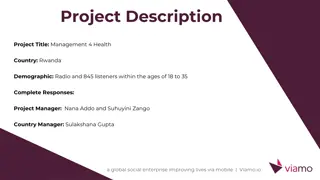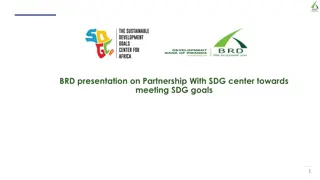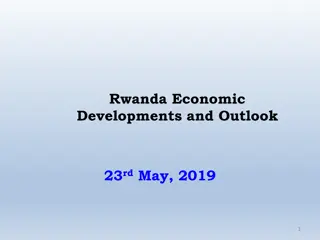Analysis of Maternal and Infant Mortality Rates in Rwanda
The analysis explores the differences between national and international reported indicators such as Maternal Mortality Ratio, Infant Mortality Rate, and Antenatal Care Coverage in Rwanda. It discusses challenges in data collection, potential underreporting, and misclassification affecting maternal and infant mortality data. Variations in figures between national and global reports are highlighted, shedding light on the importance of accurate data for public health policies.
Download Presentation

Please find below an Image/Link to download the presentation.
The content on the website is provided AS IS for your information and personal use only. It may not be sold, licensed, or shared on other websites without obtaining consent from the author.If you encounter any issues during the download, it is possible that the publisher has removed the file from their server.
You are allowed to download the files provided on this website for personal or commercial use, subject to the condition that they are used lawfully. All files are the property of their respective owners.
The content on the website is provided AS IS for your information and personal use only. It may not be sold, licensed, or shared on other websites without obtaining consent from the author.
E N D
Presentation Transcript
National Institute of Statistics of Rwanda Differences Between National and International Reported Indicators April 2014 By Ruben MUHAYITETO Phnom Penh, Cambodia If you don t count, you don t count
Content 1.Maternal mortality ratio(MMR) 2.Infant Mortality Rate (IMR) 3.Antenatal care coverage for at least four visits 4.Children 1 year-old immunized against measles 5.Net enrolment ratio in primary education (NER) Differences between national and international reported indicators presented by Ruben MUHAYITETO,NISR
1. Maternal mortality ratio Maternal mortality data have limitations, particularly related to the underreporting and misclassification of maternal deaths. National: 487 The maternal mortality ratio should not be confused with the maternal mortality rate (whose denominator is the number of women of reproductive age), which reflects not only the risk of maternal death per pregnancy or birth but also the level of fertility in the population. The maternal mortality ratio (whose denominator is the number of live births) indicates the risk of death once a woman becomes pregnant, and does not take fertility levels into consideration. Differences between national and global figures could occur from the limitations mentioned above and the use of a different method globally to adjust existing data in order to produce better quality estimates. International: 340 Unit: 100,000 live births Year: 2010 Difference between national and international reported indicators presented by Ruben MUHAYITETO,NISR
2. Infant Mortality Rate (IMR) Direct estimates of infant mortality based on survey data may suffer from mothers misreporting their children s birth dates, current age or age at death perhaps more so if the child has died. The heaping of deaths at age 12 months is especially common. Age heaping may transfer deaths across the one-year boundary and lead to underestimates of infant mortality rates. Global figures produced by the inter-agency group for infant mortality estimation (IGME) may differ from the ones produced at the country level for different reasons. The global estimates use all available data obtained from different sources (vital registration, census, and household surveys) to produce estimates that represent trends and levels of infant mortality in the country. This is done by applying a regression model, described in the section below. Another source for difference between global and national figures could arise from the limitations mentioned above. National: 50 International:59 Unit: per 1000 live births Year: 2010 Difference between national and international reported indicators presented by Ruben MUHAYITETO,NISR
3. Antenatal care coverage for at least four visits Antenatal care coverage for at least 4 visits is the percentage of women aged 15-49 who had a live birth in the 5 years preceding the survey and who received antenatal care provided by skilled health personnel (doctors, midwives, medical assistant or nurse) at least 4 times during pregnancy. Skilled health personnel: (accredited health professionals) - such as a midwife, doctor, medical assistant or nurse - who have been educated and trained to proficiency in the skills needed to manage normal pregnancies, childbirth and the immediate postnatal period, and in the identification, management and referral of complications in women and new-borns. Both trained and untrained traditional birth attendants (TBA) are excluded. Unlike for international definition, Antenatal care coverage for at least four visits considers women aged 15-49 who received antenatal care from ANY provider. Otherwise, there are no differences between Global and National figures. National:35.4 workers/attendants International:35.4 (uncomplicated) Unit: percent Year: 2010 Difference between national and international reported indicators presented by Ruben MUHAYITETO,NISR
4. Children 1 year-old immunized against measles National:95.0 Estimates based on surveys have advantages and disadvantages. The principal advantages of surveys are that an estimate of immunization coverage can be obtained even if the denominator is unknown and vaccinations given by the private sector are included. In addition, because they include individuals who have not been vaccinated, reasons for not vaccinating can be identified. The principle disadvantage of surveys is that they provide information on the previous birth year s cohort (making it difficult to use for timely programme intervention). Also Recall error could be a potential bias in the data. In household surveys for those where vaccination cards were not available, the respondent may or may not know or remember if her child had received the specific vaccination. Rwanda uses Household surveys (DHS) to get vaccination estimates whereas the World Health Organization (WHO) and the United Nations Children's Fund (UNICEF) compile country data series based on both types of data gathered through the WHO/UNICER Joint Reporting Form (JRF) on Vaccine- Preventable Diseases. International:82 Unit: percent Year: 2010 Difference between national and international reported indicators presented by Ruben MUHAYITETO,NISR
Net enrolment ratio in primary education (NER) National:91.7 children s birth certificates may not exist or are not checked by school heads. Currently in Rwanda, children are increasingly completing primary school at a higher age. For every two children aged 7 to 12, there is one over 12 years attending primary school. Misreporting of enrolment by age is more difficult to overcome as International:98.7 Nationally-published figures may differ from the international one because of the adjustment made on net enrolment ratio in primary education for the global monitoring of the Millennium Development Goals. Unit: Percent Year: 2010 Difference between national and international reported indicators presented by Ruben MUHAYITETO,NISR
Thank you for your attention!!! Difference between national and international reported indicators presented by Ruben MUHAYITETO,NISR























